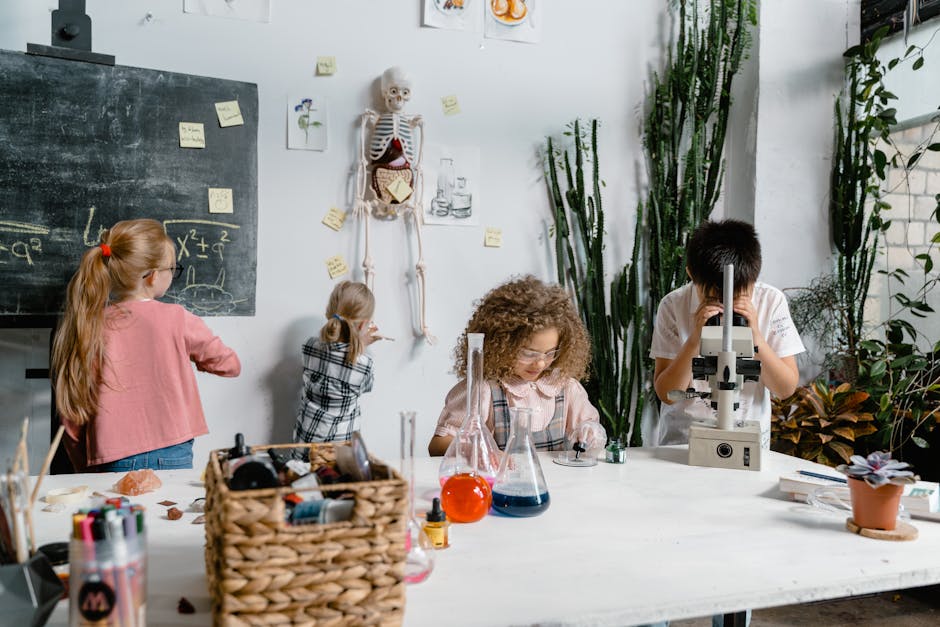Learning is a journey that takes many forms, guided by the diverse ways in which individuals absorb, process, and retain information. From the vivid imagery that captivates visual learners to the hands-on experiences that engage kinesthetic learners, each style presents its own pathway to understanding. This overview sheds light on the various learning styles, offering insights into how recognizing and adapting to these preferences can enhance the educational experience for both learners and educators alike.
Overview of Learning Styles
Visual learners thrive when information is presented in diagrams, charts, or any visual format. They find it easier to understand and remember things by seeing them. This style involves the use of visual aids like drawings, highlighting texts, and using symbols or colors to organize information. Watching videos or looking at images can be particularly beneficial for these learners.
Auditory learners, on the other hand, prefer listening to understand new concepts. They learn best through lectures, discussions, and debates. For these individuals, reading information aloud or using mnemonic devices can significantly enhance their learning process. Podcasts, recordings, and verbal instructions are valuable tools for auditory learners.
Reading/writing learners have a strong preference for interacting with the written word. They excel in situations where information is communicated through text. These learners find comfort in jotting down notes, reading handouts, and using lists to organize their thoughts. They are often meticulous note-takers and can absorb information effectively by transforming complex diagrams or charts into written descriptions.
Kinesthetic learners are the most hands-on learning type. They learn best by doing, experiencing, and experimenting. These individuals need to physically engage with the material to grasp it fully. This may involve using physical objects, participating in labs, or employing real-world examples to anchor their learning. They benefit from being able to move around and engage their senses as they learn.
Understanding one’s learning style can significantly impact how effectively one absorbs, processes, and retains new information. It enables learners to tailor their study habits and techniques to align with their strengths, making the learning experience more efficient and enjoyable. For educators, recognizing the diverse learning styles in a classroom can help in designing courses that accommodate all learners, ensuring a more inclusive and effective learning environment.
Each learning style has its unique set of strengths and challenges. Visual learners might struggle with purely verbal instructions, while auditory learners might find it hard to learn through visual aids alone. Similarly, reading/writing learners could have difficulty with hands-on tasks that kinesthetic learners would excel in. Thus, it’s crucial for learners to explore a combination of methods that work best for them, even if it means stepping out of their comfort zone to improve on weaker areas.
The key to successful learning lies not just in knowing your primary learning style but in leveraging it to your advantage while being open to integrating other styles when necessary. This multifaceted approach ensures a well-rounded learning experience that can adapt to various subjects and environments. Understanding and applying one’s learning style fosters a more proactive, personalized, and ultimately more effective learning journey.

Photo by kellysikkema on Unsplash
Visual Learning Style
Visual learners thrive in an environment where visual cues play a starring role in the process of acquiring knowledge. For them, vivid images, charts, and diagrams are not just tools but the very pathway to understanding complex concepts and memorizing vital information. Color coding, for instance, isn’t just for aesthetic appeal; it serves as a critical organization technique that helps distinguish and prioritize data effortlessly.
When it comes to studying, these individuals find conventional notetaking to be lacking. Instead, converting notes into visual representations such as mind maps or infographics can significantly enhance their retention capacity. This transformation of text into visual format enables them to see connections, relationships, and hierarchies among the information, presenting a clear picture of the material that words alone cannot achieve.
Presentation slides are another ally of the visual learner. However, the effectiveness of slides hinges on their design. A cluttered slide with overwhelming amounts of text and disorganized information can be counterproductive. Lean slides featuring key points, relevant images, and graphs streamline the learning process, making it easier for visual learners to absorb and recall information.
Videos also offer a dynamic learning medium for visual learners, especially those that incorporate animations or illustrative visuals which break down complex topics into digestible, engaging content. These learners can gain significantly from the use of educational videos that illustrate processes, demonstrate experiments, or visualize historical events, as the moving images and pacing can be tailored to the learner’s pace.
In a classroom setting, whiteboard or chalkboard drawings serve as an effective ad-hoc visual aid, creating a live visual narrative that students can follow along. Instructors who sketch or map concepts in real-time offer visual learners an invaluable perspective on the subject matter that is both engaging and memorable.
Interactive learning environments, such as virtual labs or simulations, provide immersive experiences where visual learners can explore concepts and theories in a hands-on manner. Through these interactive experiences, learners not only visualize but also interact with the subject matter in a way that deepens their understanding and retention.
Incorporating field trips or external learning opportunities into teaching plans can bring a tangible aspect to learning for visual learners. Observing real-world applications or historical artifacts brings a depth of understanding and context that purely theoretical learning cannot match.
Utilizing graphic organizers such as charts, timelines, and flowcharts prior to starting a complex task enables visual learners to outline their approach in a visually logical manner. This prep work aids in organizing their thoughts and structuring their approach to problem-solving or project planning.
Finally, peer discussions revolving around visuals or illustrations can foster deeper comprehension. Explaining a concept with the aid of a diagram or model not only reinforces the learner’s understanding but also challenges them to articulate their thoughts and inquiries visually.
Adapting teaching methods and study strategies to accommodate visual learners not only maximizes their learning potential but also cultivates a rich, inclusive educational environment where diverse learning styles are recognized and nurtured. Through the intentional integration of these visual strategies, educators and learners alike can unlock the benefits of tailored learning approaches.

Auditory Learning Style
Now, if auditory learners are the focus, these individuals thrive when information is presented to them in an auditory format. This means that traditional lecture settings, where a teacher or speaker delivers information verbally, are often ideal learning environments for these individuals. They have a knack for remembering details from discussions and presentations, sometimes even without taking notes. Their strong suit lies in their ability to understand and retain information that they hear.
For auditory learners, engaging in group discussions is more than just a way of learning; it’s their way of cementing information. These interactive sessions allow them to process and analyze information verbally, enhancing their comprehension and retention. Whether it’s debating a topic, engaging in class discussions, or simply explaining a concept to a peer, the act of speaking and listening sharpens their understanding.
Listening to audio recordings is another powerful tool for auditory learners. Podcasts, audiobooks, and educational lectures available as audio content can be significantly beneficial. The flexibility of listening while on the move allows for efficient use of time, making it possible to absorb information during daily commutes or while performing other tasks. Incorporating this method into their learning process ensures continuous and convenient access to information.
Creating voice memos or recordings of their own voice summarizing key points from lessons or textbooks can aid auditory learners significantly. This personalized approach to study materials enables them to replay these summaries, reinforcing their memory of the subject matter.
Participation in study groups offers a two-fold benefit for auditory learners. Not only do they get to absorb information through discussion, but the opportunity to verbalize their thoughts and questions also reinforces their learning. Hearing explanations from others provides different perspectives, making complex concepts easier to grasp.
For comprehension and retention improvement, auditory learners might find it beneficial to read aloud. Whether it’s reading textbook chapters, notes, or study guides, verbalizing written content can enhance their understanding and memory. This method turns static written materials into dynamic auditory experiences, catering to their auditory preference.
Implementing background music or ambient sounds during study sessions can sometimes aid concentration for auditory learners. While this might not work for everyone, certain learners find that soft, instrumental music or nature sounds help create a conducive learning environment.
Utilizing mnemonic devices that involve rhythm and music to memorize facts can play to the strengths of an auditory learner. Creating songs or jingles to remember historical dates, mathematical formulas, or scientific principles leverages their auditory inclination for memorization tasks.
To optimize their learning process, auditory learners are encouraged to actively seek feedback through verbal interactions with instructors or peers. Engaging in conversations about their ideas and understanding allows for immediate clarification and adjustment, ensuring they’re on the right path.
By emphasizing these auditory-focused strategies, learners can tailor their education to match their preferred style, making learning more effective and enjoyable.

Kinesthetic Learning Style
Kinesthetic learners thrive in environments where they can move, touch, and interact physically with their learning materials. Unlike their peers who might prefer to absorb information through lectures or visual aids, kinesthetic learners capture knowledge best through direct, hands-on experience. This deeply physical approach to learning not only aids in comprehension but also in long-term retention of information.
To support kinesthetic learners, incorporating laboratory experiments into lesson plans provides an excellent way for these students to engage with the subject matter in a tangible manner. Whether it’s mixing chemicals to observe reactions in a chemistry class or dissecting specimens in biology, lab work allows kinesthetic learners to connect theoretical knowledge with real-world application.
Role-play scenarios offer another dynamic learning opportunity for kinesthetic learners. These activities encourage students to embody concepts or historical events, providing a unique perspective that goes beyond traditional learning methods. Role-playing can be particularly effective in subjects like language studies, history, and social sciences, where understanding multiple viewpoints or historical contexts is crucial.
Simulations and interactive models present kinesthetic learners with the chance to explore complex concepts in a controlled, yet tangible, manner. For instance, physics students can use simulation software or hands-on kits to construct and test their own engineering projects, thereby gaining a deeper understanding of physical principles at play.
Field trips stand out as an invaluable tool for kinesthetic learners, offering vivid experiences that classroom settings might not provide. Visiting historical sites, museums, or science centers gives students the chance to explore learning material in a vibrant, interactive environment. These excursions not only cater to kinesthetic learning preferences but also enrich the educational experience for all students by bridging the gap between textbook learning and real-world observation.
Incorporating movement into the classroom itself can also significantly benefit kinesthetic learners. Simple activities that require standing, walking, or gesturing can make a big difference in their engagement and retention. For example, a teacher might ask students to move to different areas of the room based on their opinion about a discussion topic or to act out scenes from a book to aid comprehension.
Technology-based resources also hold promise for kinesthetic learners. Virtual reality (VR) and augmented reality (AR) technologies immersion experiences are aligning well with kinesthetic learning styles. By engaging in virtual labs or exploring historical events through virtual tours, students can gain practical insights without the constraints of traditional classroom settings.
In summary, catering to kinesthetic learners involves creating diverse opportunities for physical involvement in the learning process. By embracing methods that allow these students to actively participate, educators can foster an inclusive atmosphere that validates and capitalizes on the unique strengths of every learning style.

Reading/Writing Learning Style
Reading/writing learners shine when they engage with text. They grasp concepts better through the written word, benefiting from a structured approach to learning that involves extensive note-taking, lists, and reading assignments. For these learners, engaging fully with the course material means immersing themselves in textbooks, articles, and written explanations.
To support reading/writing learners, one technique is encouraging detailed note-taking. This allows them to process information as they write, reinforcing their understanding. The act of rewriting notes, paraphrasing long passages into concise summaries, and bullet-listing key points can significantly enhance retention.
Lists play a significant role for reading/writing learners. By compiling lists of vocabulary words, key concepts, or even questions to explore further, these learners can create a tangible record of their learning journey. Lists help in organizing thoughts and make revisiting concepts for revision much easier.
Incorporating text-based input and output methods into the learning process can also be highly beneficial. Writing essays, reports, and even short answer questions allow reading/writing learners to articulate their understanding in a format that’s natural to them. Encouraging learners to engage with text by asking them to draft written responses to discussion questions or summarize readings reinforces their learning preference.
Moreover, exposing learners to a variety of textual resources expands their understanding. Offering access to a wide range of reading materials, including primary and secondary sources, fiction and non-fiction texts, and scholarly articles can cater to the diverse interests of reading/writing learners. Suggesting or requiring that they annotate texts as they read can further solidify their grasp on the material by making them active participants in their own learning process.
Additionally, the use of digital tools and resources can offer reading/writing learners new avenues to explore. Online forums, blogs related to course topics, and even interactive e-books with embedded assessment tools can provide engaging platforms for these learners to delve deeper into subjects of interest.
Creating opportunities for peer review and feedback on written assignments encourages reading/writing learners to refine and reflect upon their written work. This iterative process not only improves writing skills but also aids in deepening their understanding of the content.
Encouraging reading/writing learners to maintain a learning journal or diary where they can freely express their thoughts, reflections, and summaries on what they are learning can serve as a powerful tool for personal growth and knowledge retention.
Through the implementation of these strategies, educators can create a more inclusive and effective learning environment that respects and harnesses the strengths of reading/writing learners. By leveraging their natural inclination for engaging with text, these learners can enjoy a more enriching educational experience that goes beyond passive reading to active participation and exploration of the subject matter.

In conclusion, the essence of effective learning lies in acknowledging and adapting to the varied styles through which individuals engage with information. By fostering an environment that caters to visual, auditory, reading/writing, and kinesthetic preferences, educators can support a more inclusive and dynamic learning experience. The most crucial takeaway is the importance of understanding one’s own learning style. This self-awareness empowers learners to approach their education with strategies that align with their strengths, paving the way for a more personalized and impactful learning journey.
Unlock AI-powered content creation with Writio! This article was written by Writio.
Leave a Reply